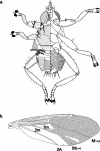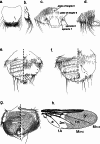The Hippoboscidae (Insecta: Diptera) from Madagascar, with new records from the "Parc National de Midongy Befotaka"
- PMID: 21678788
- PMCID: PMC3671411
- DOI: 10.1051/parasite/2011182127
The Hippoboscidae (Insecta: Diptera) from Madagascar, with new records from the "Parc National de Midongy Befotaka"
Abstract
The Hippoboscidae or "louse-flies" is a family of pupiparous Diptera, which in their adult stage are ectoparasites of mammals and birds. This paper presents a comprehensive review of Malagasy Hippoboscidae. In total, amongst the 213 species of this family known worldwide, 14 have been reported in Madagascar, among which six are considered as endemic to the Malagasy region. In addition, data are presented from a collection of 17 Hippoboscidae obtained from seven species of forest-dwelling birds in the "Parc National de Midongy Befotaka", southeastern Madagascar, in 2003. The flies in this collection belong to three different species: Icosta malagasii (one), Ornithoica podicipis (ten) and Ornithoctona laticomis (six). The two former species were previously only known from single specimens in museum collections; the later species is distributed across much of the Afrotropical region and the records presented herein are the first for Madagascar. All the seven bird species are new hosts for hippoboscids. We present the first description of the male of Icosta malagasii. An illustrated dichotomous determination key of the 14 Malagasy species, based on morphological criteria only, is presented.
Les Hippoboscidae constituent une famille de Diptères pupipares dont le stade adulte est ectoparasite de mammifères et d’oiseaux. Nous présentons ici une revue de tous les Hippoboscidae connus de Madagascar. Parmi les 213 espèces de cette famille connues dans le monde, 14 ont été observées au moins une fois à Madagascar, parmi lesquelles six sont considérées comme endémiques de la région malgache. Nous présentons aussi la récolte de 17 Hippoboscidae adultes collectés de sept espèces d’oiseaux strictement forestiers en 2003 dans le Parc National de Midongy Befotaka, sud-est de Madagascar. Ces 17 hippobosques se répartissent en trois espèces : Icosta malagasii (un), Ornithoica podicipis (dix) et Ornithoctona laticornis (six). Les deux premières de ces espèces étaient précédemment connues par un unique spécimen enregistré dans les collections des muséums ; O. laticornis a une large répartition en zone Afrotropicale, mais il est trouvé pour la première fois à Madagascar. Chacune des sept espèces d’oiseaux constitue un nouvel hôte pour les hippobosques collectés. Nous proposons la première description du mâle d’Icosta malagasii. Nous présentons enfin une clé dichotomique illustrée, basée exclusivement sur des critères morphologiques, pour la détermination des 14 espèces malgaches.
Figures






References
-
- Baker J.R.A review of the role played by the Hippoboscidae (Diptera) as vectors of endoparasites. J Parasitol, 1967, 53 (2), 412–418 - PubMed
-
- Bequaert J.C.Notes on Hippoboscidae 13. A second revision of the Hippoboscinae. Psyche, 1939, 46, 70–90
-
- Bequaert J.C.The Hippoboscidae or louse-flies (Diptera) of mammals and birds. Part II. Taxonomy, evolution and revision of American genera and species. Entomol Am, 1954, 34, 1–232
-
- Brunhes J.Les insectes hématophages de l’archipel des Comores (Diptera, Culicidae, Ceratopogonidae, Simuliidae, Tabanidae, Hippoboscidae et Muscidae Stomoxyinae; Hemiptera Cimicidae), maladies transmises et méthodes de lutte, in: Faune entomologique de l’archipel des Comores Mémoires du Muséum National d’Histoire Naturelle, Nouvelle Série, Série A, Zoologie, 1978, 109, 193–246
-
- Cogan B.H., Hutson A.M. & Shaffer J.C.Preliminary observations on the affinities and composition of the insect fauna of Aldabra. Phil Trans Roy Soc London B, 1971, 206, 315–325
Publication types
MeSH terms
LinkOut - more resources
Full Text Sources
